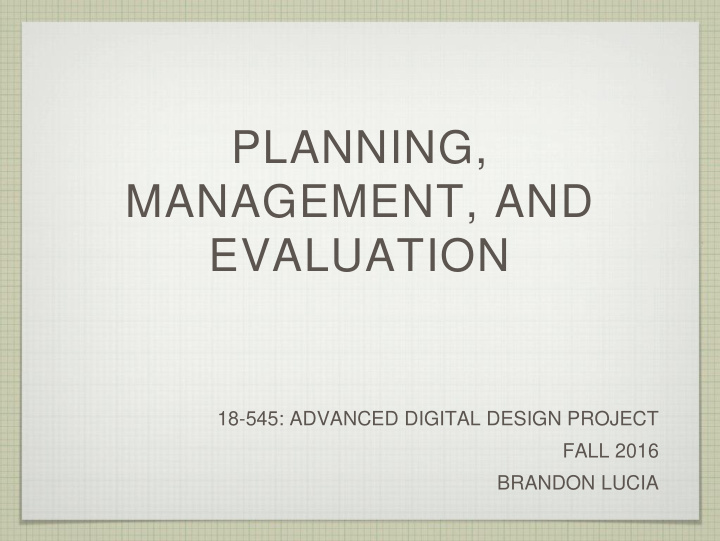



PLANNING, MANAGEMENT, AND EVALUATION 18-545: ADVANCED DIGITAL DESIGN PROJECT FALL 2016 BRANDON LUCIA
Product Development Steps Concept Refinement Realization Production PLANNING 3 18-545: FALL 2016
Today’s Talk Planning Managing yourself and others Tools and automation Design advice Metrics and Evaluation 4 18-545: FALL 2016
Planning Planning step is critical (“If you fail to plan, you are planning to fail...”) Planning: determining tasks / timescale / resources needed to accomplish the project goals Sets the tone for the rest of the design Plan now, save time later Experience with poor planning teaches good planning 5 18-545: FALL 2016
Plan of Record Define your PoR, even if it may change Eliminate ambiguity: ambiguity contributes to failure Tolerate revision: Some decisions will be wrong Prioritize: Spend time on what matters, not what is easy. Document your PoR: written plans stick. 6 18-545: FALL 2016
Plan like a Realist Be Concrete: If you don’t plan for it, it (probably) won’t get done “If we have time, we’ll do X” ; almost never happens Face challenges: Ignoring issues makes them worse! Late changes break more Surprise changes can torpedo your project. 7 18-545: FALL 2016
“One must imagine Sisyphus happy” -Albert Camus, The Myth of Sisyphus Pragmatism rules: Some work is fun, some is painful, all is needed Design to the Goal: What is interesting? What will you demo? What must you test? What is the “falling boulder”? What can you cut (if no time)? 8 18-545: FALL 2016
Planning and Design Planning is design; design is planning Specification Partitioning Tools Schedule 9 18-545: FALL 2016
Specification Define success early : over- engineering wastes valuable time Define the what: Features, power, performance, cost Define the how: Partitioning, implementation, and interfaces Test for success: metrics allow comparison to success 10 18-545: FALL 2016
Partitioning Modular decomposition Software Workstation Embedded CPU (e.g., ARM) Soft CPU (e.g., MicroBlaze) Hardware FPGA + core configs Peripherals on/off-board Divide hardware into major blocks Computation, Memory, Control Most projects naturally decompose 11 18-545: FALL 2016
Scheduling Aids Gantt Chart Only useful if living “Density” represents parallelism; “width” represents sequentiality 12 18-545: FALL 2016
“…never let go [of your Gantt Chart]” - R o s e D e w i t t B u k a t e r C a l v e r t , T i t a n i c Schedule realistically Plan how long things take, not how long you want them to take Plan slop time Design Review Surface “lost” problems Near RTL completion time 13 18-545: FALL 2016
Schedule (3) Maintain the schedule: Past performance predicts future Evidence-based Scheduling: everyone has a "time constant” Team Scheduling Some teammates need more/less ramp-up time Some have other commitments (classes,quals,job) Some are busy and/or apathetic Accountability to schedule is key 14 18-545: FALL 2016
Prepare for Schedule Slip Quicksand of failure Time remaining Plateau of Inaction Shallow grade of realism Precipitous slope of surprising success Deadline Time 15 18-545: FALL 2016
“No [person] is an island [except Kevin Costner in 1995 cinematic masterpiece Waterworld ]” -John Donne, Devotions upon Emergent Occasions, 1624 You cannot succeed in 18-545 alone Coordination is work : but worth it. Teammates cannot read your mind Communication is key 16 18-545: FALL 2016
Standards so high, you’ll Fosbury Flop Clarity in Goals: you and your teammates agree on deliverables Record in the schedule Be strict: (with yourself and your teammates) Uniformity: All held to a standard Excellence: All hold a high standard Ambition: All strive to hit the standard "I have a bad back," Fosbury said after his victory, "and I lost a big patch of skin on the back of my left heel. Then I tripped on some stone steps the other day and strained a ligament in my right foot. I guess I use positive thinking. Every time I approach the bar I keep telling myself, 'I can do it, I can do it.' “ - ”Fearless” Dick Fosbury, Inventor of the Fosbury Flop, 1968 17 18-545: FALL 2016
Work Together Organize Regular Meetings “Sequential” meetings increase later “parallelism” Share solutions and tips Meetings are deceptively necessary Golden Rule: Don’t be a bad teammate. Be the way you want your teammates to be Do quality work on time 18 18-545: FALL 2016
Design Pitfalls Special cases (add complexity) Regularity and standardization are good Overly clever, under smart Over-engineering the sub-blocks at expense of the system Need to do both top-down and bottom-up design Hacking at problems Design through iteration can be bad Stop, pop-up, rethink 25 18-545: FALL 2016
26 18-545: FALL 2016
How Not to Plan a Project 27 18-545: FALL 2016
How Not to Plan a Project 28 18-545: FALL 2016
How to fail? Do not maintain, stick to, continuously revise your schedule. Take on too much, over-deliver where unnecessary, ignore time Work alone, do not communicate, stay at home, write nothing down Never test, assume it works, commit without docs, dedicate most time to “technical purity” Do not anticipate surprise, do not change plans ever, be stubborn Stay home on demo day 29 18-545: FALL 2016
Recommend
More recommend